
 |
|||
Conference MaterialAssessing Students' Science Learning: A Multi-faceted Approach
THREE LITTLE PIGS WRITING PROMPT Soils (STC) Grade Level: 2 Linda Cole, Michele Lombard, Marty Gelhaus, Jennifer Oakes, and Shirley Bergman North Penn School District, PA:
This task was introduced after students had worked with sand, clay, and humus and had completed several tests (after Lesson 5 in STC Soils kit). The unit works best during the second or third marking period. We wanted to know if students could observe and note the differences in color and texture in a real-life situation. The task takes 30-45 minutes, but more time would be given if the students needed it.
Benchmarks (K-2)
Background information: This unit is more effective if taught no earlier than November in the school year. Students need to be able to work cooperatively with partners and to know what is expected during lab time. This is too challenging earlier in the year. Prior to this assessment task, students had already had experience with each of the three materials. They had completed several of the tests - smear, ball, and settling and had read the sand/clay story in the module (pgs 65-67)--Have You Seen Sand or Clay Today?--which describes the uses of the materials. Materials used: Writing prompt, crayons from the kit with colors that match the earth materials, pencil. Task procedure: After reading the story Have You Seen Sand or Clay Today?, provide each student with a copy of the prompt and crayons from the kit. Read it orally to them and allow the student to complete it independently.
In this procedure, we were looking for science content knowledge; not the mechanics of writing. We were looking student understanding of the connection between clay and bricks and if they knew that bricks would be able to withstand rain.
The students are familiar with rubrics from language arts. They saw the rubric ahead of time and could look at completed papers and decide what is a 4, 3, etc. All of the children identified clay as the best material. The rubric refers to the quality of the explanation (their reasons why) and the amount of detail in the drawing.
*Conferencing and modifications may be needed for students with special needs
While students were writing, we still had the clay ball, sand, and humus in the classroom. We brought it to their desks so they could look at it again. In working with ESL students who may not understand the task (because of the language barrier) the teacher may want to sit down with the student and ask some in-depth questions. It was important to have the children take what they knew and had learned, and apply it to the writing prompt. Children in our classrooms have had experience using writing prompts in different subjects. If the children were not familiar with The Three Little Pigs, (e.g., ESL students), it should be read to them first.
For the most part, we found that the students' written responses for this task were better than was typical in their journals. This may be because the journals are more open-ended and there is not enough help in organizing their writing. This prompt was motivational - the drawing and writing around the story of the three pigs. Their pictures showed their enthusiasm for the task. A time limit was set, but students could continue working if they needed more time. The results were satisfactory - all of the children got the concept that clay is the important building material. They had a clear understanding following their experiences and could apply what they learned. If they don't understand the properties of these materials, they may not be ready to go on to the next investigation - mystery mixtures. We were trying to figure out whether they understood the characteristics of the materials. Could they use that information to solve a problem. These assessments make you much more aware because you have to look at the students' work and really think about it. Does this make sense? Sometimes we have to go and check their answers or ask a colleague. It is different than just checking ABBAB, etc. on a multiple choice test. You have to know what is happening and why. It causes the students to keep observing and questioning. I tell them, "You will never look at soil in the same way again." It's not easy to convert to letter grades, but it does show the level of understanding. I can show parents the student's work and the rubric so they can see what the expectations were. At back to school night I tell them that we do not use a textbook or paper and pencil tests.
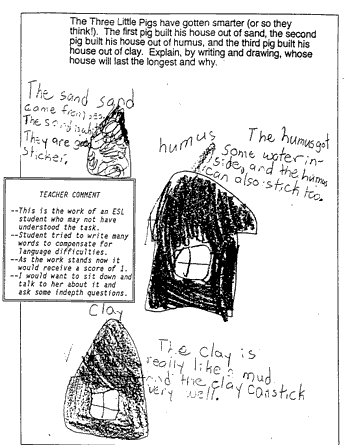
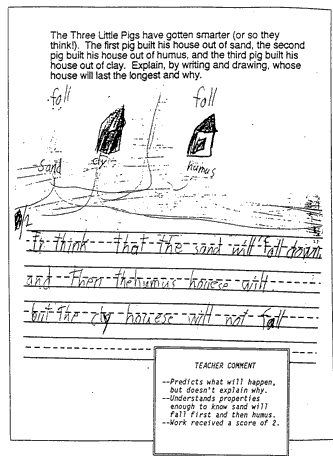
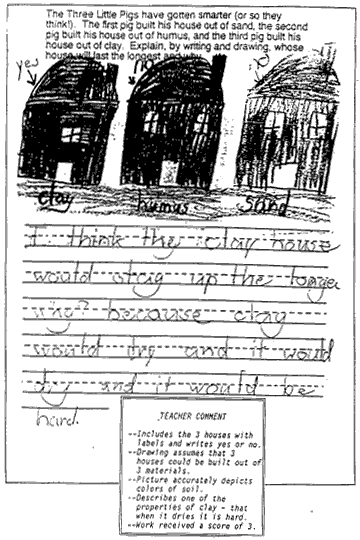
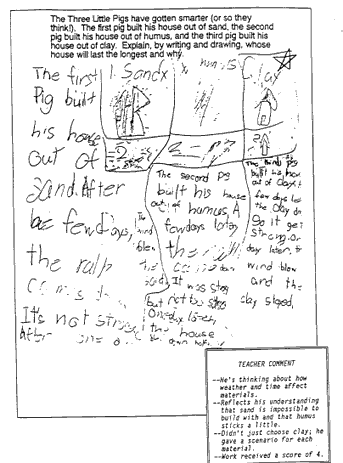
OBSERVING AND DEFINING THE PROPERTIES OF A ROCK Earth Materials (FOSS) Grade Level: 4 Patty Bradshaw, Gerard Kuenze, Margo Bartiromo, and Lois Eckelman Rahway School District, New Jersey
The purpose of this task was to find out if students could identify rocks by physical properties and chemical tests; identify the properties that were most and least useful, and use the tools - measurements and scratch test. Were they aware of the properties, and did they understand that there were many different properties they could look at? We also wanted to see if they could present the material in a clear manner. This assessment task was used primarily as a post- assessment, although one teacher also used it as a pre-assessment (see Comments and Recommendations). Two class periods of thirty minutes each are needed (one for investigating rocks and preparing written observations and another for sharing these observations orally). This assessment comes at the end of the unit and about 8 to 12 weeks into the school year.
National Science Education Standards (K-4) Properties of Objects and Materials. Objects have many observable properties, including size, weight, shape, color ... Those properties can be measured using tools, such as rulers, balances. . . p. 127 Properties of Earth Materials The varied materials have different physical and chemical properties ... p. 134
Materials used: The teacher prepares rock sets. The sets should be made up of pairs of rock samples so that there are at least ten matching pairs and one set with three matches (in case of an odd number of students in a class). Number paper cups from 1-20 with a marker on the bottom of the cup. Place one rock sample in each cup and record the matching numbers on a key for teacher reference. Other materials: /index card to record observation, graph paper, paper clips, pennies, hand lenses, electronic balance, tape measure, magnets, cylinder with water, vinegar, plastic cups, colored pencils, crayons. Task procedure: The students work individually and write their own paragraphs. They share their readings as a large group and then they try to match their rocks to the written paragraphs. Day One: The teacher distributes an /index card and rock sample to each student. The student records his/her name and number of rock sample on the /index card. Students are then instructed to make observations and describe the properties of their rock sample on the /index card. Students are encouraged to use any materials available in the room to enrich their descriptions. Allow one class period for the rock observation. Collect the rock samples and /index cards until the next class period. Day Two: The teacher redistributes each student's /index card and rock sample. (Students get their own rock sample and /index card again). The teacher informs the class that each student has a rock that matches another student's rock in the class. The teacher now instructs the class that each student will be reading his description orally. The other students will be listening to the description read with the purpose of finding their matching rock. At this point, the teacher may suggest that some properties maybe more useful for identification purposes than others. Solicit appropriate responses from students indicating the properties they think will be most useful (i.e., texture, luster) and least useful (i.e., size and weight). One student begins to read from his list of observations. Other students respond if they think that their rock is a match based on the oral reading. If more than one student thinks his rock matches the oral reading, then the reader must listen to those students read their observations and pick the one that he thinks matches. The teacher using the answer key confirms matches. Students with mismatches are encouraged to continue to listen for their match. Oral reading continues until all students have found their rock matches. The teacher should keep a record of students who have found their matches, as an incentive for students to remain on task while they're listening to others read their observations, a reward system can be assigned for finding a match. For instance, 5 homework points to students when their match is made. All students win eventually find their match by process of elimination. After all students have found their match the teacher instructs each student to add to their written observation the properties that were most and least useful in finding their match. Collect the written observations.
As stated in the Context section, this activity could also be used as a pre-assessment. However, other ways to structure the pre-assessment might also include: 1.A more simplified version in which the teacher asks the students to bring in their own rock and write a paragraph describing it. Then they mix up their rocks and leave them in the middle of their table. They go to another table and see if they can identify the rocks based on the students' descriptions. 2.Describe properties of some other object (fruit, spices in ajar, or peanuts). Stress the importance of students indicating their most and least important property or properties after the oral sharing portion of the activity.
You learned if the student is acquiring the language to communicate. That is the toughest part of the activity. They can measure, etc., but the hardest part is communicating in a clear, concise way. This assessment is richer than the old ones. The communication is the key. A lot of our kids could point to an answer and draw a picture. When you look at their picture, you expect to be able to tell which of the mock rocks is theirs. They are developing the ability to focus in on narrow parameters. LE: The communication skill is most subjective. When we look at the students' explanations, we (the teachers) did not always agree. When they show you the tools that they use, etc. that is more objective. The more they have down that is pertinent, even if they are missing 4 or 5 of the important properties, it shows that they have a perspective. PB: I liked the comparison between their own descriptions in the beginning on three note cards. They can see how they have grown when they do the note cards at the end. It is really just describing a rock both times, GK: Each year I feel a little more effective; I learn new things. I become more comfortable with my understanding. The first year the teacher's guide was a bible. I can do more things now; have more confidence. We now have extras that we add. I wrote a salt story: salt supply (for salting the streets after snow) gets wet. Students have to describe what they would do and submit their response "top secret" in an envelope. I test whether they really understand evaporation. MEB: We learned the number of properties they knew; the extent of their use of tools and their ability to communicate. Every year that I do this module I am a little more pleased. I suppose it is because of the way I prepare them. I know more about where we are going and about the pitfalls. I have more ability to infuse an inquiry-based approach without leaving them in chaos. At the beginning of the year they don't know the tools (measurement) that are available. We just introduced them to the electronic balance. The increased experience is beginning to show itself Today we talked about measuring inches versus centimeters. The reasoning about how the size of the object should match the units of measurement is more familiar. They know how to use the measurement tools. They have had to experience it. In general, we felt that the set of skills taught in this unit is appropriate for this grade level; that the unit is in the right place,
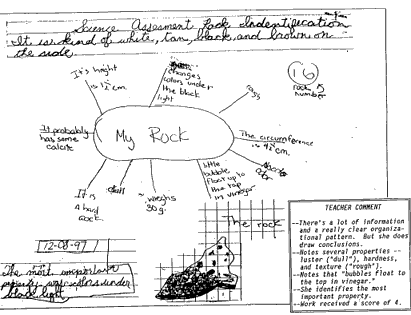
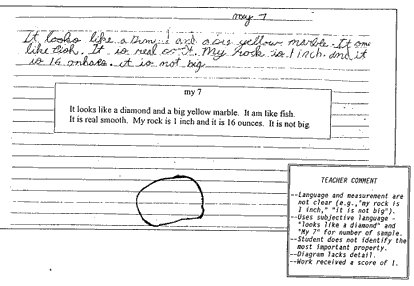

DESIGN A PLANT EXPERIMENT Environments (FOSS) Grade Level: 5 Karyn M. Chemidlin, Kathy Maglione, Maria Pizzelli, JoAnn Bolduc Linden School District
This assessment task took place after an eight week study of environments with the focus on controlled investigations. The purpose was to find out if students understood controlled investigations. This unit was at the beginning of the school year-, it was their first experience with inquiry based experiments or controlled experiments in fifth grade. Two days are needed for planning and set up. Then one to two weeks needed for observations and conclusions. Other lessons/units can be introduced during the interim.
National Science Education Standards Abilities Necessary to do Scientific Inquiry (5-8) Identity questions, design and conduct investigations, gather and analyze data, develop explanations built on evidence, think critically, analyze alternative explanations, communicate, use mathematics. p. 145 Organisms and their Environment's (K:4) An organism's patterns of behavior are related to the nature of that organism's environment, including the kinds and numbers of other organisms present, the availability of food and resources, and the physical characteristics of the environment. When the environment changes, some plants and animals survive and reproduce, and other die... p. 129
Materials used: Students generate a list of materials needed to conduct their investigation. Task Procedure: Based on previous experiences with plant investigations, students working in small groups design their own controlled experiment based on a testable question Directions might include: 1.List all of the materials you will need to conduct this investigation. You will only be able to take materials that you have listed. Include detailed amounts ... how much what kind. Testable Question: A testable question defines the purpose of the investigation. It can be investigated, and possibly answered through a controlled experiment. The results should be observable, and should either prove or disprove the hypothesis. For example: Will Darkling Beetles prefer moist environments over dry environments? Journal Writing: After each activity students are asked to compose a journal entry that consists of four parts:
NOTE: This is a helpful guide when grading journals-- I part-D, 2 parts-C, 3 parts-B, 4 parts-A)
5th Grade Rubric
Testable Question: appropriate or reasonable; fits in a time frame; can be answered by conducting an experiment and done in a reasonable time frame. Hypothesis: a prediction based on prior information that will answer the question. Material: fist amounts (i.e.; five seeds) Procedure: sequential steps Observations: a detailed written description of observations relative to the investigation Conclusion/Reflection: shows that the hypothesis can either be proved or disproved based on the data.
Teachers tried various groups: pairs, groups of 4 - 6, and groups of 4 - 5. All if these included mainstreamed students. Try to have enough materials in groups of 4 - 6 so they could split into pairs and work together. Expected more competent students to provide guidance to others. One teacher: 7 languages represented in the classroom (did not have English as a first language) some in bi-lingual programs or just out of the program. Many do not think in English. But they all succeeded in science and were able to earn high grades. Much time spent on how to communicate; modeling and practicing so that each child had a chance to be an active learner. Students wrote in their journals and read to one another to get help with editing their writing. Teachers may want to build the experimental procedure incrementally:
An extension of the process could include the use of a testable question in other areas (e.g., social studies). Can they use this inquiry approach in other subject areas?
Since the students designed each experiment on their own they had to explain it more so the teacher would know what they did. The result demonstrated that they could write a journal better than they normally would. We learned that the students were able to use more of the vocabulary they needed to explain an experiment than when following a standard experiment. This design-your-own experiment was more real to them. They showed more ownership, and their journals were written with much more specific details. We were better able to se their level of knowledge because they had more freedom. This showed more of a true understanding. It directed our instruction in that we spent more time actually talking about the procedures, discussing the variables and the controls. Then they wrote up their own conclusion and some came up with their own ideas. We learned that some needed much more guidance than others did in the methods and procedures of gathering materials., Some needed more direct instruction. Teachers should not be frustrated if they have limited success the first time. It worked better when broken into small steps on different days. Guide them through developing testable questions and deciding which materials to use. You have to practice all of the components before you use this project as an assessment. You have to adjust your expectations to the amount of experience and practice they have doing this. They are just starting to read the road map. Based on observing the students' needs, we introduced similar tasks with more guidance. We also modified tasks to give clear guidelines. Some children need an outline or a list to help them get organized.
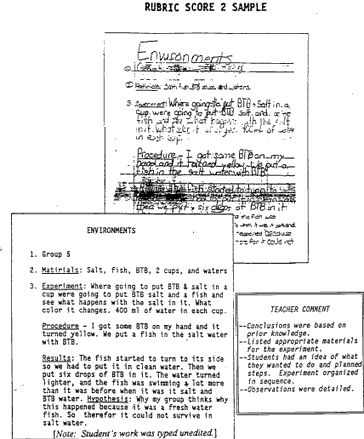

 | |||||||||||||||||||||||||||||||||||||||||||||||||||||||||||||||||||||||||||||||||||||||||||||||||||||||||